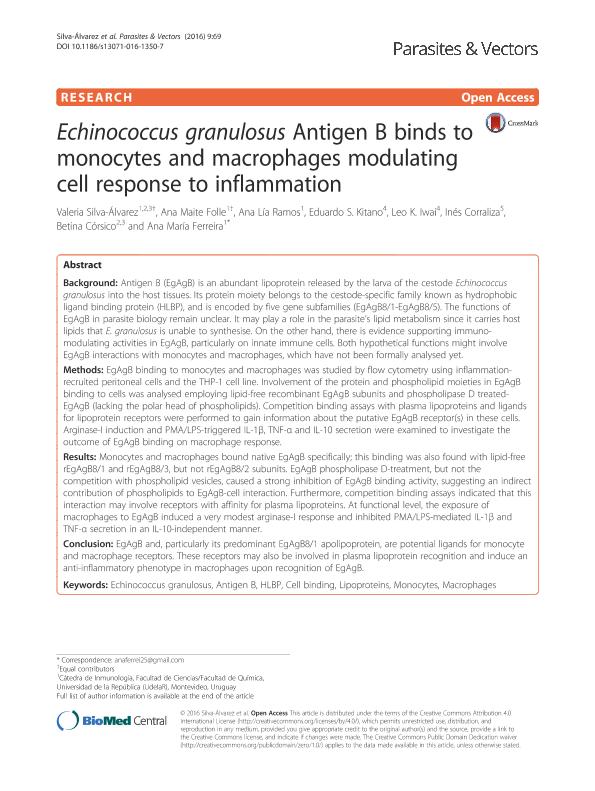Artículo
Echinococcus granulosus Antigen B binds to monocytes and macrophages modulating cell response to inflammation
Silva Álvarez, Valeria; Folle, Ana Maite; Ramos, Ana Lía; Kitano, Eduardo S.; Iwai, Leo K.; Corraliza, Ines; Córsico, Betina ; Ferreira, Ana María
; Ferreira, Ana María
 ; Ferreira, Ana María
; Ferreira, Ana María
Fecha de publicación:
02/2016
Editorial:
BioMed Central
Revista:
Parasites and Vectors
ISSN:
1756-3305
Idioma:
Inglés
Tipo de recurso:
Artículo publicado
Clasificación temática:
Resumen
Background: Antigen B (EgAgB) is an abundant lipoprotein released by the larva of the cestode Echinococcusgranulosus into the host tissues. Its protein moiety belongs to the cestode-specific family known as hydrophobicligand binding protein (HLBP), and is encoded by five gene subfamilies (EgAgB8/1-EgAgB8/5). The functions ofEgAgB in parasite biology remain unclear. It may play a role in the parasite?s lipid metabolism since it carries hostlipids that E. granulosus is unable to synthesise. On the other hand, there is evidence supporting immunomodulatingactivities in EgAgB, particularly on innate immune cells. Both hypothetical functions might involveEgAgB interactions with monocytes and macrophages, which have not been formally analysed yet.Methods: EgAgB binding to monocytes and macrophages was studied by flow cytometry using inflammationrecruitedperitoneal cells and the THP-1 cell line. Involvement of the protein and phospholipid moieties in EgAgBbinding to cells was analysed employing lipid-free recombinant EgAgB subunits and phospholipase D treatedEgAgB(lacking the polar head of phospholipids). Competition binding assays with plasma lipoproteins and ligandsfor lipoprotein receptors were performed to gain information about the putative EgAgB receptor(s) in these cells.Arginase-I induction and PMA/LPS-triggered IL-1β, TNF-α and IL-10 secretion were examined to investigate theoutcome of EgAgB binding on macrophage response.Results: Monocytes and macrophages bound native EgAgB specifically; this binding was also found with lipid-freerEgAgB8/1 and rEgAgB8/3, but not rEgAgB8/2 subunits. EgAgB phospholipase D-treatment, but not thecompetition with phospholipid vesicles, caused a strong inhibition of EgAgB binding activity, suggesting an indirectcontribution of phospholipids to EgAgB-cell interaction. Furthermore, competition binding assays indicated that thisinteraction may involve receptors with affinity for plasma lipoproteins. At functional level, the exposure ofmacrophages to EgAgB induced a very modest arginase-I response and inhibited PMA/LPS-mediated IL-1β andTNF-α secretion in an IL-10-independent manner.Conclusion: EgAgB and, particularly its predominant EgAgB8/1 apolipoprotein, are potential ligands for monocyteand macrophage receptors. These receptors may also be involved in plasma lipoprotein recognition and induce ananti-inflammatory phenotype in macrophages upon recognition of EgAgB.
Palabras clave:
Echinococcus
,
Antigenob
,
Monocito
,
Inflamacion
Archivos asociados
Licencia
Identificadores
Colecciones
Articulos(INIBIOLP)
Articulos de INST.DE INVEST.BIOQUIMICAS DE LA PLATA
Articulos de INST.DE INVEST.BIOQUIMICAS DE LA PLATA
Citación
Silva Álvarez, Valeria; Folle, Ana Maite; Ramos, Ana Lía; Kitano, Eduardo S.; Iwai, Leo K.; et al.; Echinococcus granulosus Antigen B binds to monocytes and macrophages modulating cell response to inflammation; BioMed Central; Parasites and Vectors; 9; 69; 2-2016; 1350-1357
Compartir
Altmétricas



